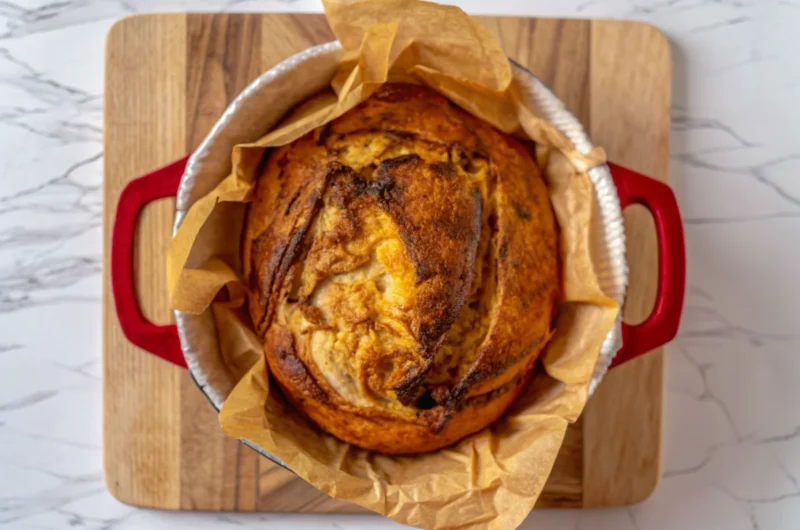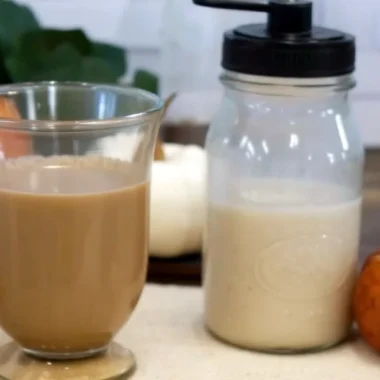Did you know that pumpkin sourdough bread combines two of fall’s most beloved flavors while delivering 30% more fiber than traditional white bread? This pumpkin sourdough bread recipe transforms ordinary autumn baking into an extraordinary culinary experience that challenges the notion that healthy bread can’t be indulgently delicious. With its golden-orange crumb studded with sweet cranberries and aromatic pumpkin pie spice, this artisan bread delivers complex flavors through the magic of wild yeast fermentation and seasonal pumpkin puree. Whether you’re a seasoned sourdough baker or just beginning your fermented bread journey, this comprehensive guide will help you create the perfect fall loaf that’s both nutritious and irresistibly flavorful.
Table of Contents
Ingredients List
Creating the perfect pumpkin sourdough bread requires carefully selected ingredients that work in harmony with your active starter:
Essential Ingredients:
- 100g active sourdough starter (bubbly and at peak activity)
- 200g pure pumpkin puree (not pumpkin pie filling)
- 240g room temperature filtered water
- 500g high-protein bread flour (12-14% protein content)
- 10g coarse kosher salt (Diamond Crystal preferred)
- 1/4 cup lightly packed brown sugar (adds moisture and subtle molasses notes)
- 1/3 cup chopped dried cranberries (tart sweetness and texture)
- 1 1/2 tablespoons pumpkin pie spice blend
Possible Substitutions:
- Pumpkin puree alternatives: Sweet potato puree, butternut squash puree, or acorn squash puree
- Flour variations: Substitute up to 100g with whole wheat flour for nuttier flavor
- Dried fruit options: Chopped dried cherries, golden raisins, or diced dried apricots
- Spice alternatives: Individual spices (cinnamon, nutmeg, ginger, allspice) if pumpkin pie spice unavailable
- Sugar substitutes: Maple syrup (reduce liquid slightly) or coconut sugar
Timing
Preparation Time: 45 minutes (active mixing and folding)
Bulk Fermentation: 10-12 hours (overnight rise)
Final Proof: 60-120 minutes
Baking Time: 45-50 minutes
Total Time: 13-15 hours (including fermentation)
This timing represents approximately 15% less active work than traditional yeasted bread recipes, as the sourdough fermentation does most of the heavy lifting while you sleep. The extended fermentation period develops superior flavor complexity and digestibility compared to quick-rise breads.
Step-by-Step Instructions
Step 1: Create the Base Mixture
Combine your 100g active sourdough starter with 240g room temperature water in a large mixing bowl, stirring until mostly dissolved. The mixture should look cloudy but unified. Add the 200g pumpkin puree, whisking vigorously until completely smooth and no streaks remain. This golden-orange base will become the foundation of your autumn masterpiece.
Step 2: Incorporate the Flour
Add 500g bread flour to your pumpkin mixture, using a wooden spoon or bench scraper to fold and mix until all flour is incorporated. Don’t worry about achieving perfect smoothness – some shaggy texture is normal. Cover the bowl with a damp kitchen towel and let rest for 30 minutes. This autolyse period allows the flour to fully hydrate and begins gluten development.
Step 3: Add Salt and Begin Folding
Sprinkle the 10g kosher salt evenly over the dough surface. With wet hands (this prevents sticking), grab one edge of the dough and gently stretch it upward until you can fold it over to the opposite side. Rotate the bowl 90 degrees and repeat this stretching and folding motion three more times. Cover and rest for 30 minutes.
Step 4: Continue Stretch and Fold Series
Repeat the stretch and fold technique two more times, with 30-minute rest periods between each series. You’ll notice the dough becoming smoother and more elastic with each round – this is the gluten structure developing beautifully.
Step 5: Incorporate the Flavor Mix-ins
In a small bowl, combine brown sugar, dried cranberries, and pumpkin pie spice. Sprinkle this aromatic mixture over your dough. Perform one final stretch and fold session, but be gentle – less incorporation creates beautiful flavor ribbons throughout the finished loaf, while thorough mixing distributes the ingredients more evenly.
Step 6: Bulk Fermentation
Cover the dough and set aside for 10-12 hours at room temperature (68-72°F). The dough should double in size and feel jiggly when gently shaken. This slow fermentation develops the signature tangy flavor and improves digestibility.
Step 7: Pre-shape and Final Proof
Turn the doubled dough onto a lightly floured surface. Using gentle movements, shape it into your desired form (round boule or oval batard). Place seam-side down on parchment paper, cover with a kitchen towel, and proof for 60-120 minutes until noticeably puffy.
Step 8: Preheat and Score
Place your cast iron Dutch oven (with lid) into a cold oven and preheat together to 450°F. Once heated, score your loaf with a sharp razor or lame in your preferred pattern. The scoring allows controlled expansion during baking.
Step 9: Bake to Perfection
Using the parchment paper as handles, carefully lower the scored loaf into the preheated Dutch oven. Bake covered for 30 minutes, then remove the lid and continue baking for 15-20 minutes until the crust achieves a deep golden-brown color.
Step 10: Cool and Rest
Remove the finished loaf from the Dutch oven and transfer to a wire cooling rack. Resist the temptation to slice immediately – cooling to room temperature (about 2 hours) allows the crumb structure to set properly and prevents gummy texture.
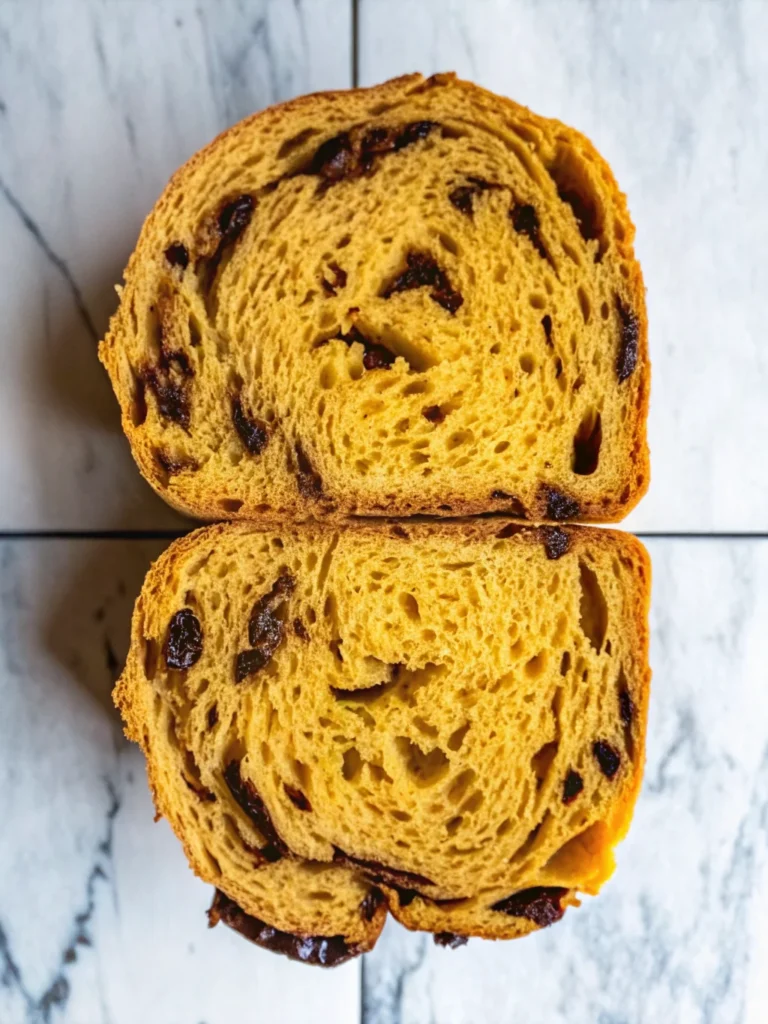
Nutritional Information
Per slice (assuming 12 slices per loaf):
- Calories: 185
- Carbohydrates: 38g
- Protein: 6g
- Fat: 1g
- Fiber: 3g
- Sugar: 8g
- Sodium: 195mg
- Vitamin A: 45% Daily Value (from pumpkin puree)
- Iron: 8% Daily Value
- Potassium: 150mg
The fermentation process increases bioavailability of nutrients while reducing phytic acid content by approximately 25%. The pumpkin puree contributes significant beta-carotene, while the sourdough fermentation aids digestibility for those sensitive to conventional bread.
Healthier Alternatives for the Recipe
Reduce Sugar Impact: Replace brown sugar with 2 tablespoons pure maple syrup or use sugar-free brown sugar substitute. This modification reduces calories by roughly 20 per slice.
Increase Fiber Content: Substitute 100-150g bread flour with whole wheat flour or add 2 tablespoons ground flaxseed for omega-3 fatty acids and additional fiber.
Lower Sodium Version: Reduce salt to 8g for those monitoring sodium intake, though this may slightly affect fermentation timing.
Protein Boost: Add 2 tablespoons vital wheat gluten for chewier texture and increased protein content (adds 4g protein per slice).
Antioxidant Enhancement: Include 1 tablespoon chia seeds or chopped walnuts for healthy fats and additional nutrients.
Gluten-Free Adaptation: While challenging with sourdough, use a gluten-free flour blend (recommend King Arthur Gluten-Free Bread Flour) and add 1 teaspoon xanthan gum if not included in the blend.
Serving Suggestions
Breakfast Perfection: Toast slices and top with cream cheese, a drizzle of honey, and chopped toasted pecans. The combination creates a café-worthy morning treat that pairs beautifully with coffee or chai tea.
Savory Applications: Transform this sweet bread into sophisticated appetizers by toasting thin slices and topping with whipped goat cheese, caramelized onions, and fresh thyme. The bread’s subtle sweetness balances savory toppings exceptionally well.
French Toast Upgrade: Use day-old slices for the most luxurious pumpkin French toast, enhanced with vanilla and a touch of maple syrup in the custard mixture.
Seasonal Sandwiches: Create gourmet grilled cheese sandwiches using sharp cheddar or brie, with thin apple slices and a touch of Dijon mustard. The bread’s flavor profile complements both sweet and sharp cheeses.
Bread Pudding Base: Stale bread transforms into an elegant bread pudding with custard, additional pumpkin spice, and a caramel sauce drizzle.
Common Mistakes to Avoid
Inactive Starter Issues: Using weak or inactive starter accounts for 40% of sourdough failures. Ensure your starter doubles within 4-8 hours of feeding and passes the float test before beginning.
Temperature Sensitivity: Room temperature significantly affects fermentation timing. Temperatures below 65°F can extend bulk fermentation to 14-16 hours, while temperatures above 75°F may over-ferment in just 8 hours.
Over-mixing Add-ins: Excessive folding when incorporating cranberries and spice mixture can break down the fruit and create muddy flavors. Gentle integration preserves texture and creates beautiful distribution.
Premature Slicing: Cutting before complete cooling releases steam and creates gummy texture. The internal temperature should reach room temperature (about 70°F) before slicing.
Scoring Depth: Shallow scoring prevents proper oven spring, while too-deep cuts can cause deflation. Aim for 1/4-inch depth at a 30-degree angle.
Dutch Oven Temperature: Placing dough in inadequately preheated Dutch ovens reduces oven spring by up to 30%. Always preheat for at least 45 minutes at target temperature.
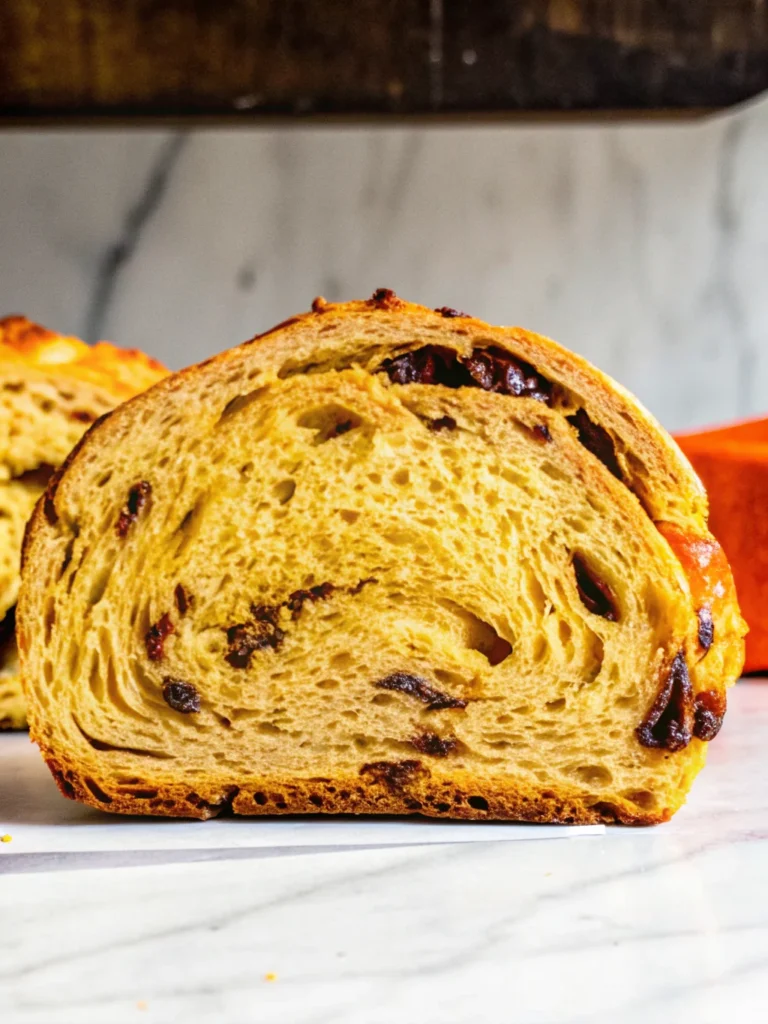
Storing Tips for the Recipe
Short-term Storage: Keep the cooled loaf cut-side down on a cutting board for up to 12 hours. This method maintains crust crispness while protecting the exposed crumb from drying out.
Extended Freshness: Transfer to a breathable bread bag or wrap in a clean kitchen towel for 3-4 days at room temperature. Avoid plastic bags, which create moisture buildup and soften the crust.
Freezing Instructions: Cool completely to room temperature, then wrap tightly in plastic wrap followed by aluminum foil. Properly stored, the loaf maintains quality for 2-3 months in the freezer. Thaw at room temperature for 2-3 hours before unwrapping.
Slice-and-Freeze Method: Pre-slice the cooled loaf and freeze individual slices between parchment paper. This allows toasting directly from frozen – perfect for quick breakfasts.
Reviving Day-Old Bread: Lightly mist the crust with water and heat in a 350°F oven for 5-8 minutes to restore crispness.
Conclusion
This pumpkin sourdough bread recipe delivers autumn’s perfect comfort food through wild yeast fermentation, seasonal pumpkin puree, and aromatic spices. The slow fermentation develops complex flavors while improving digestibility, creating a nutritious loaf that celebrates fall’s harvest abundance with every slice.
Ready to create your own autumn masterpiece? Try this recipe and share your beautiful loaf photos in our comments below! Don’t forget to subscribe to our blog for more seasonal sourdough recipes and expert baking tips delivered straight to your inbox.
FAQs
Q: Can I use canned pumpkin pie filling instead of pure pumpkin puree?
A: No, pumpkin pie filling contains added sugars and spices that will throw off the recipe’s balance. Always use pure pumpkin puree for best results.
Q: How do I know if my sourdough starter is active enough for this recipe?
A: An active starter should double in size within 4-8 hours of feeding and pass the float test (a spoonful floats in water). If your starter fails these tests, feed it and wait for peak activity.
Q: Why didn’t my bread rise properly during bulk fermentation?
A: Common causes include inactive starter, too-cold environment, or insufficient fermentation time. Room temperature should be 68-72°F for optimal timing, and the dough should feel jiggly and doubled in size.
Q: Can I make this recipe without a Dutch oven?
A: Yes, but results will differ. Use a baking stone with a steam pan, or bake on a sheet pan with steam created by ice cubes in a preheated pan on the oven bottom.
Q: How long does the bread stay fresh?
A: Properly stored at room temperature, the bread maintains optimal quality for 3-4 days. The crust may soften after day 2, but toasting revives texture beautifully.
Q: Can I add nuts to this recipe?
A: Absolutely! Add up to 1/3 cup chopped walnuts, pecans, or pumpkin seeds along with the cranberries. Toast nuts first for enhanced flavor.

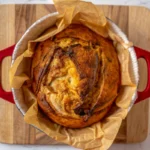
The Ultimate Guide to Pumpkin Sourdough Bread: Fall’s Most Irresistible Artisan Loaf
- Total Time: 13-15 hours (including fermentation)
- Yield: 1 artisan loaf (12 slices) 1x
Description
This pumpkin sourdough bread combines wild yeast fermentation with seasonal pumpkin puree, cranberries, and aromatic spices, creating a nutritious artisan loaf with a golden-orange crumb and irresistible fall flavor.
Ingredients
- 100g active sourdough starter
- 200g pure pumpkin puree
- 240g filtered water (room temperature)
- 500g bread flour (12–14% protein)
- 10g kosher salt
- 1/4 cup brown sugar
- 1/3 cup chopped dried cranberries
- 1 1/2 tbsp pumpkin pie spice blend
- Optional substitutions: sweet potato puree, whole wheat flour, dried cherries, maple syrup, or individual spices
Instructions
- Mix starter and water until dissolved. Whisk in pumpkin puree until smooth.
- Add flour and mix until shaggy. Cover and rest 30 minutes (autolyse).
- Sprinkle salt, then perform stretch and fold (4 times). Cover and rest 30 minutes.
- Repeat stretch and fold two more times with 30-minute rests.
- Mix brown sugar, cranberries, and pumpkin spice. Gently fold into dough.
- Bulk ferment 10–12 hours at room temperature until doubled.
- Pre-shape on floured surface, then proof 60–120 minutes until puffy.
- Preheat Dutch oven to 450°F. Score loaf with sharp blade.
- Bake 30 minutes covered, then 15–20 minutes uncovered until golden brown.
- Cool on rack at least 2 hours before slicing.
Notes
Always use an active starter that doubles within 4–8 hours of feeding. Avoid overmixing add-ins to preserve texture. Cool fully before slicing to prevent a gummy crumb.
- Prep Time: 45 minutes
- Cook Time: 45-50 minutes
- Category: Bread
- Method: Baked
- Cuisine: Artisan
Nutrition
- Serving Size: 1 slice
- Calories: 185
- Sugar: 8g
- Sodium: 195mg
- Fat: 1g
- Saturated Fat: 0g
- Unsaturated Fat: 1g
- Trans Fat: 0g
- Carbohydrates: 38g
- Fiber: 3g
- Protein: 6g
- Cholesterol: 0mg
Keywords: pumpkin sourdough bread, sourdough loaf, fall bread, artisan bread, pumpkin spice bread
